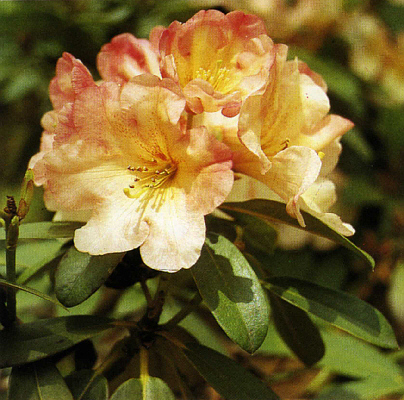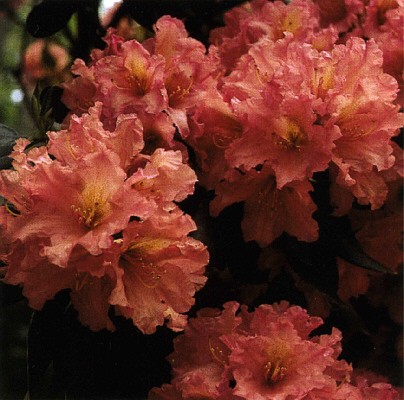Personal Observations of the Dexter Rhododendrons
By Eveleth Cowles, with Susan Cowles, Wellesley, Mass
Reprinted from the Rosebay
Interest in Dexter rhododendrons, as evidenced by the recent listing in the American Rhododendron Society Plant Registry, hints to the importance these plants may have in future breeding programs.
After observing the plants and hybridizing with them for eight years on the Dexter Estate, we have a fair estimate of their potential. We hope that our experience can be of use to others working with Dexter material.
A surprising number of the plantings on the estate did have identification. In some cases this must be taken with a grain of salt, as it has become obvious that plants identified as species were very often hybrids. Those of English origin, such as plants obtained from the Farquhar nursery, are often from open-pollinated seed. As a result, it probably is accurate to describe the Dexter rhododendrons as
R. fortunei
complex hybrids.
Editors Note: The following 17 Dexter Hybrids were registered and described in the ARS Bulletin, Spring 1978.
Examples of ones closest to the species
R. fortunei
and
R. decorum
are 'Dexter's Peppermint' (DE #215) and 'Dexter's Spice' (DE #968). These have tall rangy growth best suited to woodland plantings. On Cape Cod, 'Dexter's Spice' sometimes lost a few buds and the large blooms tend to develop brown spots. When crossed with 'Dexter's Horizon' (DE #480), it produced seedlings that when grown under light bloomed at thirty months. These were clear pink, fragrant, and weather resistant but at an early age showed the strongly upright growth of 'Dexter's Spice.' For anyone intent on fragrance, 'Dexter's Spice' or 'Dexter's Peppermint' make a good starting point.
'Dexter's Pink Glory' (DE #219) is an example of other
fortunei
hybrids. It is completely pollen sterile, but sets seed readily. 'Dexter's Pink Glory' formed a rather compact bush in an area where it had plenty of space. 'Dexter's Brandy Green' (DE #491) is another that sets capsules like pickles. This variety combined unusual buff color with pronounced hardiness. It never lost a bud, even after a winter of extended sub zero weather, to -14°F. In common with other cream to buff individuals, the leaves have an olive cast. Some pollen-sterile varieties have very large, intensely fragrant blooms that tend to wilt in a hot spell. 'Dexter's Pink Glory' and 'Dexter's Brandy-Green' lack fragrance, but make up for it with substance. 'Dexter's Skyglow' (#9) is a very hardy variety with yellowish leaves. Although it exhibits strong
R. fortunei
characteristics, it has moderate growth.
The previous plants are considered by many to be "typical Dexters". Another group in the
R. fortunei
complex exhibits opposite characteristics - compact growth rather than lanky habit, and a tendency to mature slowly. These are the
R. decorum
x
R. haematodes
hybrids that have been sought after by connoisseurs. The blooms usually have a cream to yellow undertone.

|
|
R. 'Dexter's Springtime'
Photo by Heritage Plantation |
In varieties such as 'Dexter's Springtime' (DE #314) and 'Dexter's Vanilla' (DE #997) the buds are pink to salmon. The open creamy blooms have either a pink edge as in 'Dexter's Springtime,' or salmon reverse as in 'Dexter's Vanilla.' 'Dexter's Orange' (DE #296) and 'Dexter's Brick Red' (DE #427) show yellow in the throat, and the rose overlay glows in charming blends of peach to brick. 'Dexter's Orange' has proved an interesting parent. Crossed with
R. yakushimanum
it produces heavily felted progeny and delicately colored, occasionally attractive blooms. Further hybridizing would probably result in better blooms. Breeding 'Dexter's Orange' to 'Elizabeth' produced compact plants with gorgeous foliage, which unfortunately proved root tender. 'Dexter's Orange' crossed with dichroanthum hybrids show potential for true orange color. Further experimentation aimed to shorten the time to bloom is needed here.
Although these varieties all have dense low growth, 'Dexter's Brick Red' is conspicuous in being semi-recumbent. This, combined with rich color, makes it a likely candidate in a breeding program. The greatest drawback to growing R. decorum x haematodes hybrids is that Cape Cod is their practical northern limit. Some have performed well in Ipswich, but they do not bloom every year. In Sandwich, 'Dexter's Vanilla' frequently lost some pips. This variety had blossoms that were more trumpet-shaped than the others, and probably has different parentage.
An obvious cross for Charles O. Dexter to make was that of the
R. fortunei
series with Catawba hybrids. Seedlings were produced and disseminated in great numbers. These developed into hardy robust plants with good foliage and large flower trusses in a range of pinks.

|
|
R. 'Dexter's Victoria'
Photo by Heritage Plantation |
'Dexter's Victoria' (DE #441) and 'Dexter's Appleblossom' (DE #631) are good examples. 'Dexter's Crown Pink' (DE #600), which Mr. Dexter called "Old Wavy Leaf", has an unusual characteristic. Two or three buds bloom together, forming a massive multiple truss. A lot in Sandwich labeled
R. decorum
x Mrs. C. S. Sargent resembles the majority of the plants blooming at the Ben P. P. Moseley estate in Ipswich. A number of these are indifferent in color, but some combine clean tones with attractive ruffling. Some plants of Mrs. C.S. Sargent parentage are picotee, with a strongly contrasting bright color to the edge of the bloom. As 'Amphion' grew on the estate, it is possible that this two-toned variety was used to some extent in hybridizing.
Doubt has been cast on whether Mr. Dexter used
R. smirnowii
in his program. A plant of this species is on the estate and although no label exists to confirm it, we believe that crosses were made and carried on to an advanced generation. One small group of plants shows
R. smirnowii
derivation by rugose foliage and the elongated rhachis, or central stem, of the whole truss. The best of this group was propagated and named 'Dexter's Horizon' (DE #480). It has open growth, dark foliage (which is unfortunately very susceptible to lace-wing), and the deep pink blooms have a contrasting blotch. Corresponding features in 'Scintillation' lead us to believe that this variety may represent a further generation. It would be very interesting to see if Scintillation would produce felted leaved progeny using a felted second parent.
When 'Britannia' and 'Pygmalion' appeared on the scene in the early 1930's, they became candidates for further breeding. The question arises as to what was produced by Mr. Dexter, and what was produced by his head gardener, Tony Consolini. Tony was a fine plantsman and a spirit of friendly rivalry existed between the two. One of Tony's favorite stories was of how in one case they competed using 'Brittania'. Tony crossed it with a hardy
R. fortunei
and Mr. Dexter with a more tender one. Mr. Dexter's cross produced low-growing plants with spectacular blooms, but they were a bit tender. 'Mrs. W.R. Coe' is one of these, and the decidedly tender DE #1001 with four inch blossoms remains in the original nursery bed. Next to it are Tony's hybrids, which are much taller, with smaller blossoms in clear pinks. All of these have 'Britannia's' characteristic bowl-shaped blossoms with a waxy texture. Anyone interested in developing hardy reds would be advised to give the Consolini hybrids a look.
Separating Mr. Dexter's work from Tony Consolini's becomes impossible with the 'Pygmalion' hybrids. The parentage in these plants grows more and more complex, at a time when Mr. Dexter was reaching an advanced age. The oldest of the 'Pygmalion' hybrids probably represent a mutual effort, which Tony carried on after Mr. Dexter died in 1943. 'Dexter's Giant Red' (DE #431) bloomed for the first time in 1960, and careful examination traced it back to a seedling started about 1947. It appears that Tony developed some beautiful creams from
R. litiense
and also
R. griersonianum
hybrids of varying quality. The original species plants were acquired by Mr. Dexter. However, he seems to have discounted
R. litiense
in breeding, and appears to have used
R. griersonianum
briefly.
Hybridizers of the future will not only wish to study the original Dexters, but to consider other material developed as a result of Dexter's love for rhododendrons.
Note from the Registrar, Ed Parker
'Dexter's Appleblossom' (DE #631) was registered in 1977 (Published Quarterly, A.R.S., Spring, 1978). The Dexter clone Apple Blossom (Everitt #3), which is different from 'Dexter's Appleblossom', cannot be registered as the name has been registered previously for entirely different plants. Both Dexter plants have been fairly widely distributed.